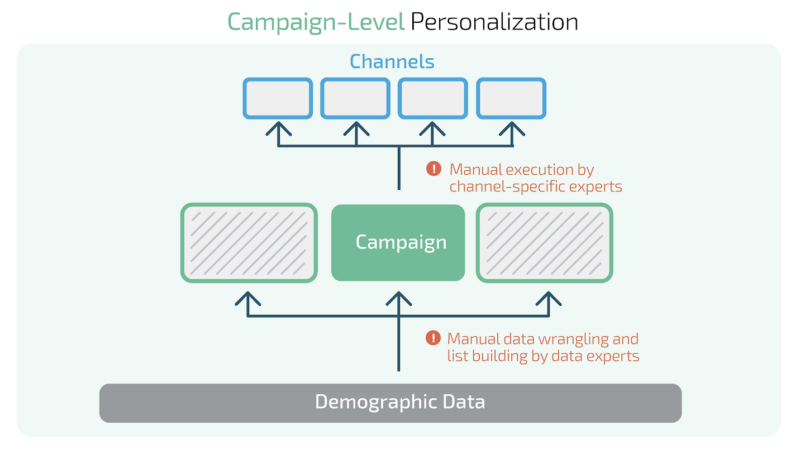Supercharge your martech stack to achieve personalization at scale
The heart of personalization is building agility so you can connect data sources and systems to grow and scale along with your channels.
Customers are demanding personalized experiences, not just once but across every interaction with your brand. And marketers have good reason to oblige them. A 2017 McKinsey report found:
- 41 percent of retailers surveyed reported personalization drove a 50-100 percent increase in revenue streams, largely from cross-sell.
- 15 percent said personalization grew revenues 100 to 300 percent.
Only 15 percent of retailers had fully implemented a personalization at scale strategy, according to the study.
With that much to be gained, why are there so many laggards?
Perhaps brands feel burned by limited returns on past efforts to unify their data and execution systems. They don’t want to rip-and-replace, move to a monolithic provider, or engage in yet another multi-year integration effort. But they also lack the resources to manually personalize messages channel by channel, audience by audience, customer by customer, every time they launch a campaign.
And so, according to McKinsey’s 2018 Perspectives on Personalization @ Scale report, many brands have settled for “antiquated ‘list pulls,’ basic segmentation, and campaigns that all lack the automated decision… to scale personalized interactions up.”
The fact is, now a small-footprint “smart hub” approach can speed and simplify your journey to personalization at scale. Sliding right into a martech stack, this “smart hub” can become a highly agile “brain” that connects every phase of the personalization process:
- Data. Capture all the raw signals your customers are sending you in one place—and automatically use them to enrich individual customer profiles.
- Insight. Make intelligent, AI-driven decisions based on all those signals.
- Action. Automatically push the right message to the right customer at the right time and via the right channel.
A little bit of knowledge: Channel-centric vs. customer-centric
Before examining how the personalization brain model works, let’s consider where so many brands get stuck on their road to personalization at scale.
For many, personalization is limited to individual channels. For example, their ESP system, relying only on demographic data and customers’ past email interactions, can provide some basic decisioning and automated personalization.
However, this channel-specific approach is neither true personalization nor truly scalable. The ESP, on its own, has no visibility into customer interactions in other channels, like web or mobile. That’s how brands end up sending email offers for products a customer just bought in-store or online, and how personalization can actually hurt, rather than help, your brand.
All images provided by ActionIQ.
Throwing people at the problem: Campaign-level personalization
Larger brands with the necessary tech resources can deliver more personalized experiences, at least across an individual campaign. However, in the absence of centralized personalization processes, marketers must wait in the queue after queue as tech resources manually stitch together siloed data and processes, including:
- Data analysts to source and unify disparate datasets and build lists.
- Data scientists to wrangle data, build models, and deliver actionable customer scores.
- Channel-specific experts to execute campaigns.
No wonder personalization is often “still treated like a nice add-on to a company’s existing marketing function,” as the McKinsey report finds.
The personalization brain
To scale any business process, you must centralize and automate it as much as possible. In the case of personalization, that means getting all relevant data in one place, applying intelligence and decisioning power across that unified data source, and then orchestrating actions across every single customer touchpoint.
Doesn’t that require you to commit to a monolithic solution—or build such a platform in-house? Not if you adopt what Gartner calls a “smart hub” approach.
A smart hub, i.e. customer data platform (CDP) or decisioning platform, is a “hub” in that it can connect to any data source as well as to any execution channel. It is “smart” in that it can unleash both AI as well as marketers’ deep knowledge. Instead of disconnected decisions based on fragmented data, or never-ending manual intervention, such a personalization brain centralizes and automates the entire personalization process.
It can gather all relevant customer signals. It can centralize AI-based decisioning on all that data. Finally, it can execute on those centralized decisions across any channels—including the ability to personalize messages at scale by: 1) automatically selecting optimal channels, and 2) drawing on past behaviors to tailor content on the fly.
Faster than you think
For more than a decade, brands have chased the promise of 1:1 marketing, only to have the prize snatched away as new systems and datasets undermine every attempt to integrate customer data, intelligent decisioning and omnichannel execution.
The “smart hub” approach addresses this problem by building agility at the heart of personalization. Because it can connect to any necessary data sources and systems, it can grow and scale as your channels and martech stack inevitably grow and change. That means you don’t have to play the perpetual game of catch-up that has stymied marketers for years. With the right solution, you can, in a matter of months, start to use the data you already have to deliver more compelling messages to your customers every time you interact with them.
Opinions expressed in this article are those of the guest author and not necessarily MarTech. Staff authors are listed here.
Related stories


